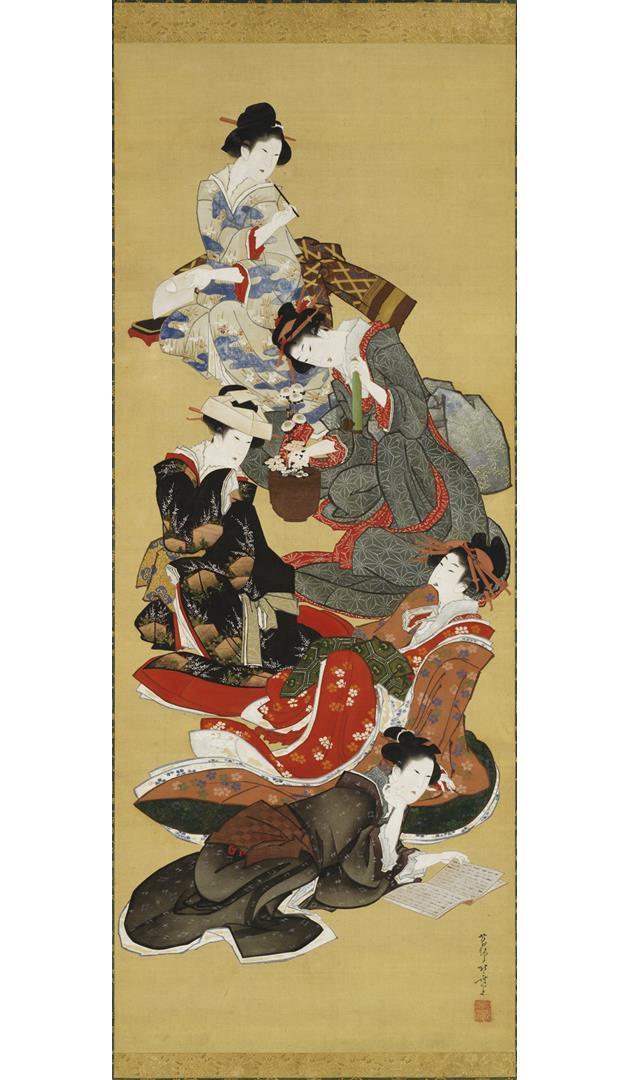Resources
Exhibition HistorySan Francisco, California, San Francisco Museum of Art, Art In Asia and the West, 1957.
Saint Louis, Missouri, Nelson-Atkins Gallery of Art and City Art Museum of Saint Louis, Art of Japan In Edo Period, 1958.
San Francisco, California, M.H. de Young Memorial Museum, Treasures of Japan, 1960.
Seattle, Washington, Seattle Art Museum, Japanese Art In The Seattle Art Museum, 1960.
Portland, Oregon, Portland Art Museum, Gift to a City: Masterworks from the Eugene Fuller Memorial Collection in the Seattle Art Museum, Nov. 3 - 28, 1965. Cat. no. 146.
Ithaca, New York, White Art Museum, Cornell University, and Munson-Williams-Proctor Institute, Utica, Japanese Painters of the Floating World, 1966.
Seattle, Washington, Seattle Art Museum, A Thousand Cranes: Treasures Of Japanese Art, Feb. 5 - July 12, 1987.
Seattle, Washington, Seattle Art Museum, From Tea Master To Townsman, Oct. 1, 1987.
Seattle, Washington, Seattle Art Museum, A Thousand Years of Beauty: Japanese Art in Seattle, July 16, 2001 - Nov. 17, 2002.
New York, New York, Asia Society, Designed for Pleasure: The World of Edo Japan in Prints and Paintings, 1680-1860, Feb. 26 - May 4, 2008.
Tokyo, Japan, Suntory Museum of Art, Luminous Jewels: Masterpieces of Asian Art From the Seattle Art Museum, July 25 - Sept. 6, 2009 (Kobe, Japan, Kobe City Museum, Sept. 19 - Dec. 6, 2009; Kofu, Japan, Yamanashi Prefectural Museum of Art, Dec. 23, 2009 - Feb. 28, 2010; Atami, Japan, MOA Museum of Art, Mar. 13 - May 9, 2010; Fukuoka, Japan, Fukuoka Art Museum, May 23 - July 19, 2010).
Seattle, Washington, Seattle Art Museum, Luminous: The Art of Asia, Oct. 13, 2011 - Jan. 8, 2012.
Seattle, Washington, Seattle Asian Art Museum, Boundless: Stories of Asian Art, Feb. 8, 2020 - ongoing [on view Feb. 8, 2020 - July 11, 2021].
Published ReferencesKOKKA, no. 671, pl. 3, 1948.
Nelson Gallery of Art, Kansas City and City Museum, St. Louis, "Art of Japan in the Edo Period", 1958, p. 16, no. 32
Sickman, L., "Floating World", Art News, LVII (3), fig. 4, pp. 26, 52, May, 1958
Fuller, Richard E. "Japanese Art in the Seattle Art Museum: An Historical Sketch." Seattle, WA: Seattle Art Museum, 1960 ("Presented in commemoration of the Hundredth Anniversary of Diplomatic Relations between Japan and the United States of America"), no. 176
Seattle Art Museum Guild, Engagement Book, 1962
Thomas, Edward B. "Oriental Art in the Seattle Art Museum," in Art in America, no. 1, 1965, illus. p. 57
"Gift to a City: Masterworks From the Eugene Fuller Memorial Collection in the Seattle Art Museum," Portland, OR: Portland Art Museum, 1965, no. 146.
Rosenfield, John M. "Ukiyo-e Paintings at Cornell University," in The Burlington Magazine, Vol. 108 No. 763 (Oct 1966), p. 533-536, illus no. 71.
White Art Museum, Cornell University, Ithaca, New York, "Japanese Painters of the Floating World", 1966, cat. no. 69, ill. p. 105
Shimada, Shujiro. "Japanese Paintings In The West", 1969, ill. #87
Graham, Donald W., "Composing Pictures", 1970, p. 83, ill.
"Universal Postal Union's 100 th Anniversary", 2 stamps and color ill., U.S. postage stamp in a special series of stamps as a tribure to international letter-writing, and reading as depicted by artists of 8 nations (detail of lower right figure), issued June 6, 1974
Rathbun, William Jay, "Beyond the Tanabata Bridge: Traditional Japanese Textiles", 1993, p. 67 illus. (color)
Loudon, Sarah. "Instructional Resources: Wearable Arts of Japan Seattle Art Museum," in Art Education, Vol. 49, No. 6, Art Education Reform and New Technologies, November 1996, 25-32
Shugo, Asano. "Concerning the Seals on Hokusai’s Paintings." In Hokusai and His Age: Ukiyo-e Painting, Printmaking, and Book Illustration in Late Edo Japan, edited by John T. Carpenter, translated by Timothy Clark, 105-133. Amsterdam: Hotei Publishing, 2005: pg 120.
Masato, Naito. "Manipulation of Form in Hokusai’s Paintings of Beauties." In Hokusai and His Age: Ukiyo-e Painting, Printmaking, and Book Illustration in Late Edo Japan, edited by John T. Carpenter, translated by Timothy Clark, 62-75. Amsterdam: Hotei Publishing, 2005: Fig. 3 and pg 67.
Sato, Tomoko, "Japanese Art", from the Art in Detail series, 2008, pg. 74
Carpenter, John T. "The Literary Network: Private Commissions for Hokusai and His Circle." In Designed For Pleasure: The World of Edo Japan in Prints and Paintings, 1680-1860, edited by Julia Meech and Jane Oliver, 143-168. Seattle: University of Washington Press, 2008: Fig. 101 and pg 144.
Applebee, Arthur N., "World Literature", McDougal Littell publisher, 2009, color illustration, pg. 505 and 560
Kawai, Masatomo, Yasuhiro Nishioka, Yukiko Sirahara, editors, "Luminous Jewels: Masterpieces of Asian Art From the Seattle Art Museum", 2009, The Yomiuri Shimbun, catalogue number 51
Takamoto, So, "Art & Beauty of Kosode", DNP Art Communications Co., Ltd. Tokyo, 2011, pg. 20
Foong, Ping, Xiaojin Wu, and Darielle Mason. "An Asian Art Museum Transformed." Orientations vol. 51, no. 3 (May/June 2020): p. 60, reproduced fig. 21.








